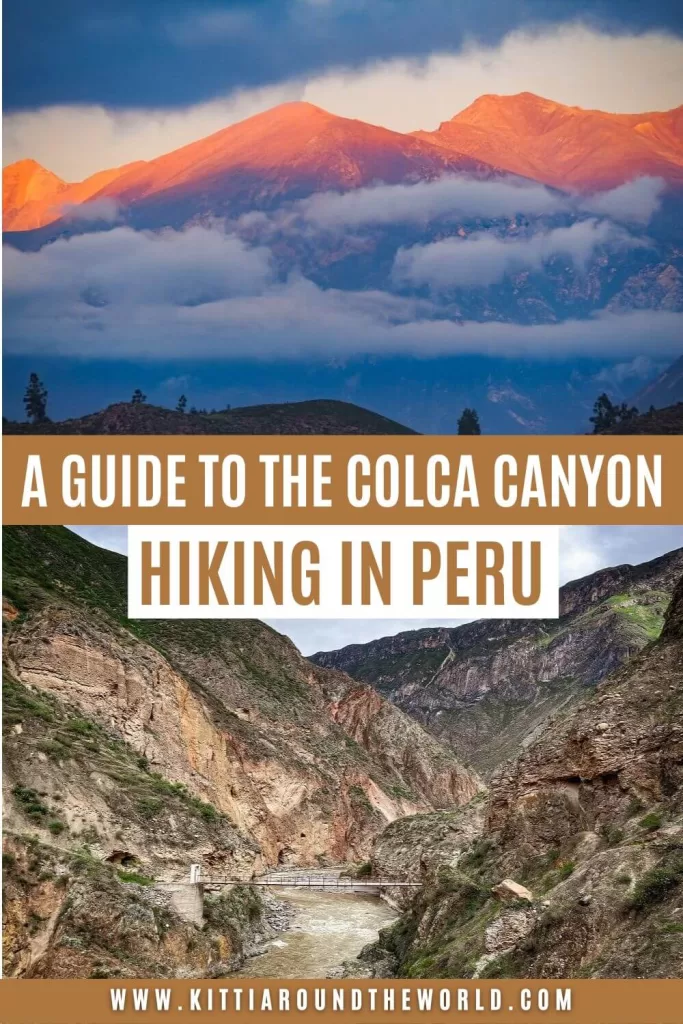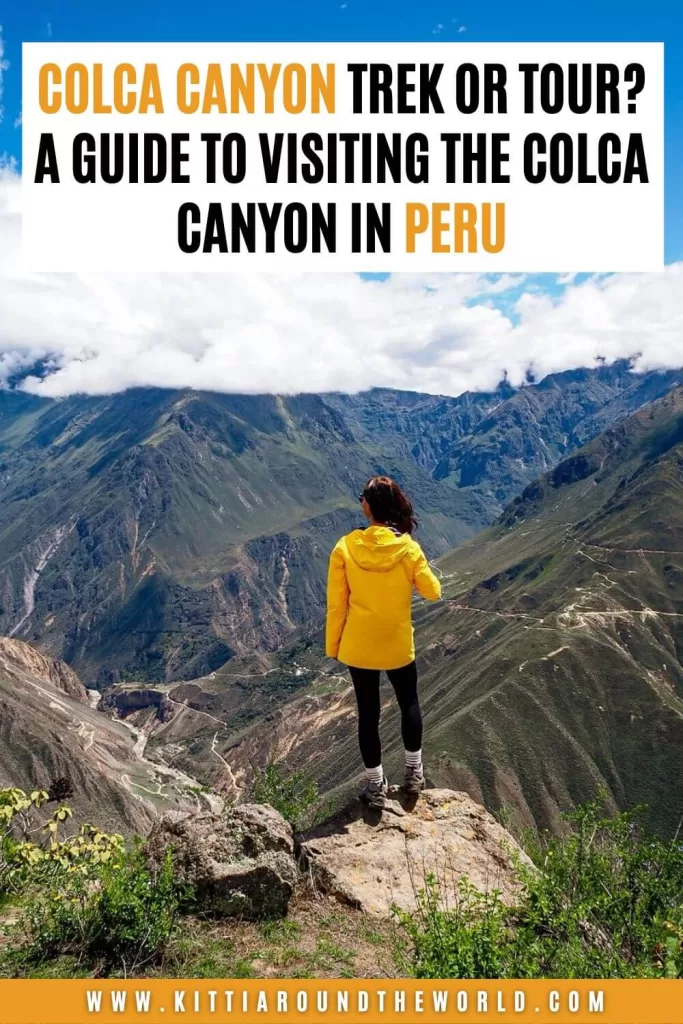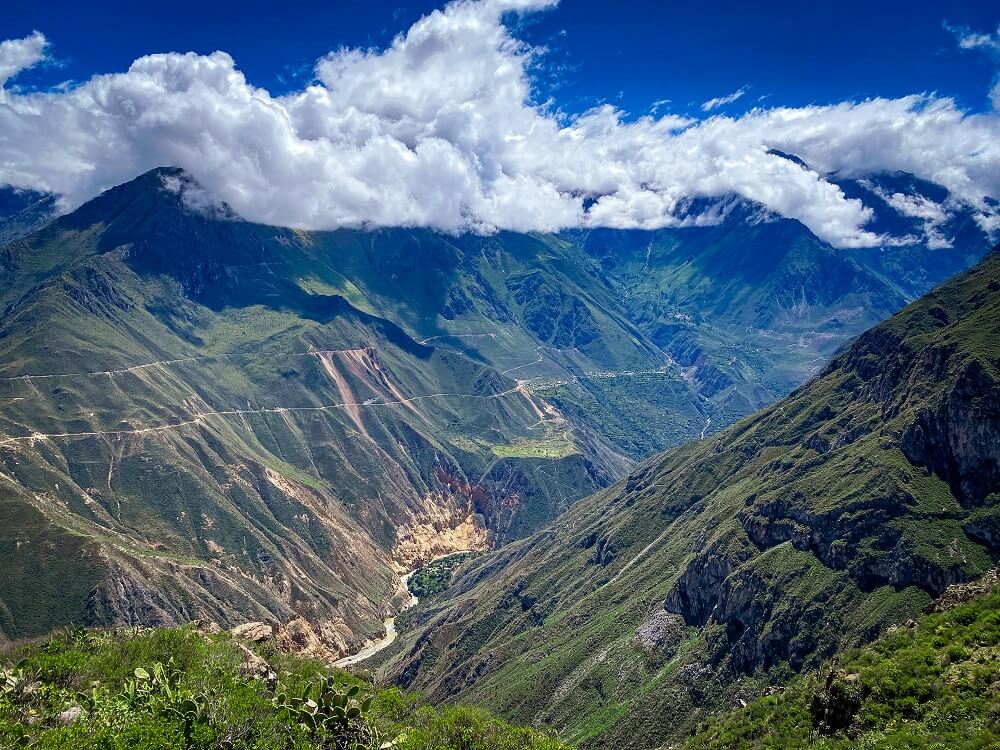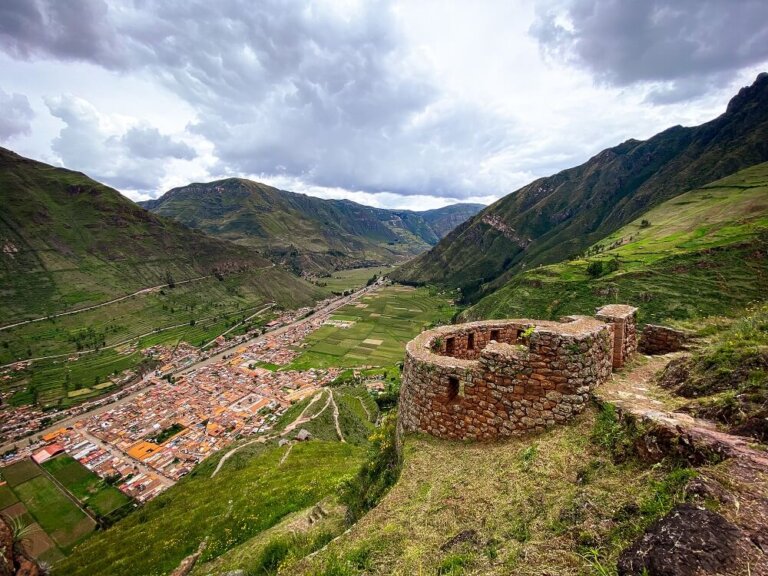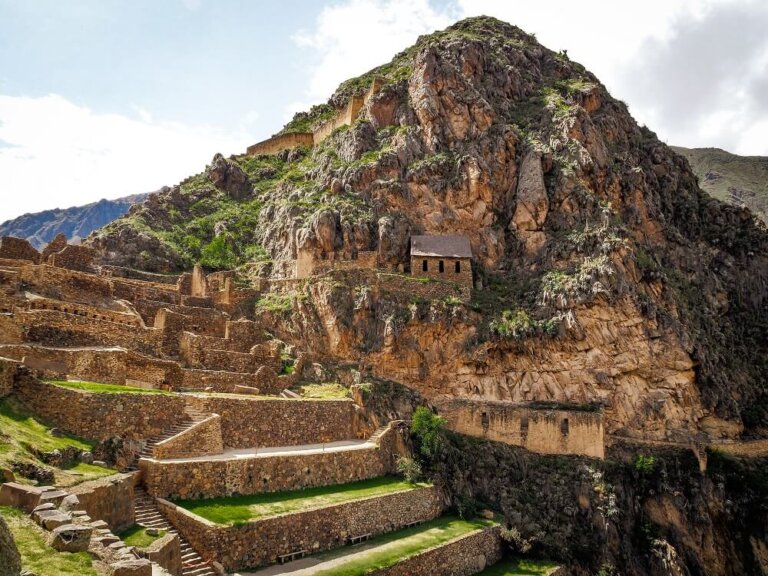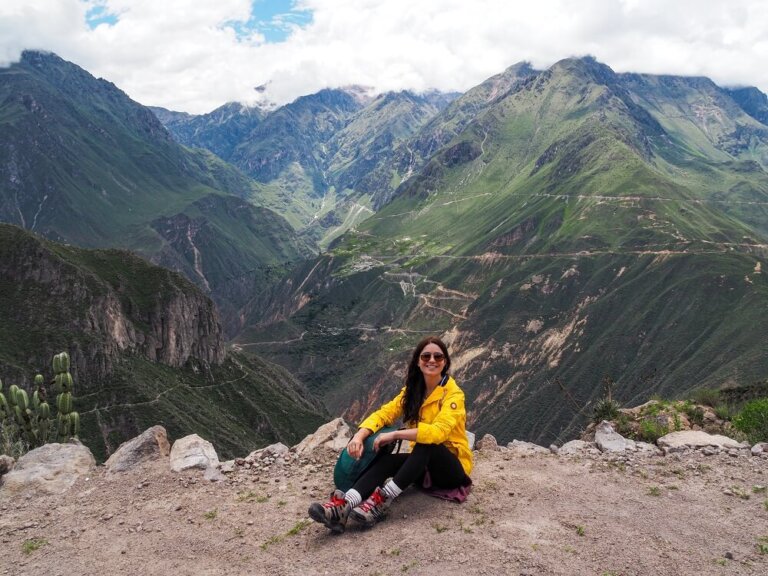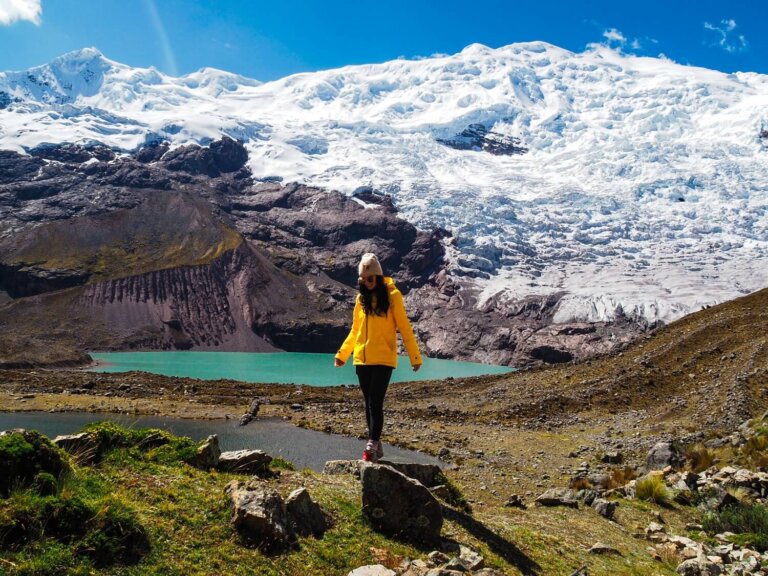Colca Canyon Trek or Tour? – How to Prepare for Your Visit
If you’re currently planning your unforgettable Peru itinerary and enjoy the outdoors, then you really cannot miss visiting or hiking in one of the world’s deepest canyons. The Colca Canyon is the third most visited place in Peru and the trek is definitely one of the most beautiful hikes in Peru.
In this blog post we’ll answer every question you might have before your visit. We detail all the most popular Colca Canyon tour and trekking options, to help you make the decision as to which one is most suited to you. We’ve included information for those wanting to visit and trek independently too. Hopefully by the end of the post, you’ll feel more prepared and ready to embark on an incredible journey through the Peruvian Andes.
In case you already know that you want to trek in the Colca Canyon, then you can check out our detailed hiking guide here. However, we still recommend reading the ‘How to prepare for your Colca Canyon Trek’ section of this post.
If you’d like to see our adventures, then check out the Colca Canyon trek video on our YouTube Channel.
Disclosure: This post may contain affiliate links, which means we may receive a small commission if you click a link and purchase something. Clicking these links won’t cost you anything, but it will help us to keep this site up and running! Learn more about our affiliate policy.
Introducing the Colca Canyon, Peru
Located about 160km northwest of Arequipa, the second largest city in Peru, is the magnificent Colca Canyon (Cañon de Colca). Situated in the Colca Valley in the Andes Mountains, the Colca Canyon was formed by a seismic fault between the volcanoes of Coropuna and Ampato.
The nearly 100km (or 70 mile) long canyon is also one of the world’s deepest canyons. Its deepest point is approximately 3,400m which makes it twice as deep as the well-known Grand Canyon in the US.
In the pre-Inca era the valley was inhabited by the communities of the ‘Collaguas’: the Quechua-speaking Cabanas and the Aymara-speakers from Lake Titicaca and the Puno area. These cultures created agricultural terraces on the hillsides that are still used today by local farmers.
The Incas arrived and slowly took control after 1320 A.D. Then the Spanish arrived after 1540, becoming the most influential group in the area.
The Colca Canyon is also home to Andean condors which are the largest flying birds in the world by combined measurement of wingspan and weight. They can weigh up to 15 kg (33 lbs) and they have a wingspan of 3.2m (10.5 ft). For comparison, that’s twice as long as me!
Did you know? The Condor is part of the Inca Trilogy along with the puma and the serpent. These three animals represent heaven, earth and the world of the dead.
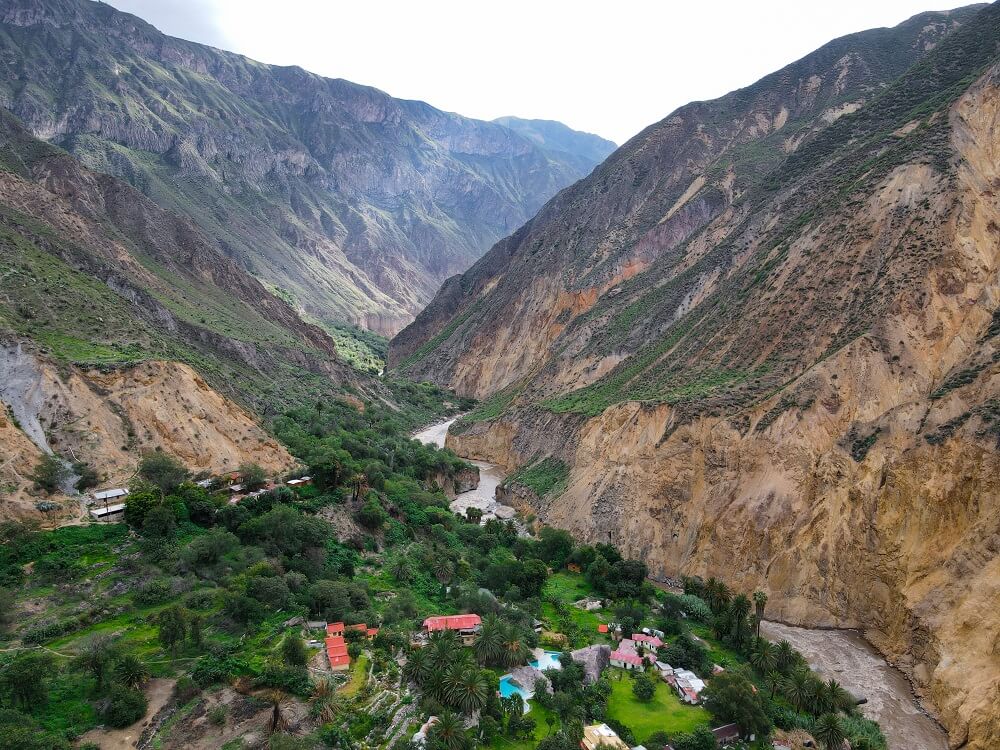
Ways to Visit the Colca Canyon in Peru
Many visitors arrive to Arequipa just to visit the Colca Canyon which makes it one of the most popular day or multi-day trips from Arequipa. Due to its popularity, you can visit the canyon in two main ways: via a tour or a trek. Now, a tour will normally include little to no hiking whereas a trek will take you down and then back up the canyon.
It’s important to read what a certain tour or trek includes to avoid any disappointment. You can always book online or in Arequipa, but always compare companies and offers before you commit to one.
Note. You’ll normally have to pay an entry fee of 70 Soles (19 USD) to enter the Colca Canyon. This cost will never be included in any tour prices. Please see the cost breakdown section for further information on how much a trip to the Colca Canyon could cost you.
1-Day Colca Canyon Tour
There are plenty of tours offering a one-day trip to the canyon. This is perfect if you’re short on time but really want to see the Colca Canyon. The cost of most one-day tours will include your private transport, a bilingual local guide, and normally one meal.
In one day you’ll get to admire the canyon from different viewpoints, see some condors at Cruz del Cóndor, stop at Patapampa (volcanoes viewpoint) and at the National Reserve of Salinas and Aguada Blanca to see some vicuñas, llamas, and alpacas. Your tour will only involve a little bit of walking but no trekking. Normally, for an additional price, you can also visit the hot springs in the town of Yanque.
2-Day Colca Canyon Tour
You can actually spend 2 days in the canyon without trekking. This is a perfect option if you have a bit longer but are not keen on hiking. Normally, a 2-day tour will include your private transport, a bilingual guide, one night’s accommodation and at least one meal.
During your tour you’ll get to see vicuñas, llamas, and alpacas at Pampa Cañahuas in the Aguada Blanca National Reserve and you’ll get to stop at multiple viewpoints of the Colca Canyon. A stop at Cruz del Cóndor is also normally included. In the evening you’ll likely be entertained by a Peruvian folklore show after enjoying the hot springs or wandering around the towns of Yanque and Chivay.
2-Day Colca Canyon Trek
The 2-day trek is probably the most popular choice for those who enjoy hiking. On your first day you’ll be trekking all the way to the bottom of the canyon. You’ll spend a night at Oasis Sangalle located at 2,100 m (6,889 ft) above sea level. Then, as you’d probably guessed, on your second day you’ll be hiking all the way back to the top.
Now, it’s worth highlighting that this can be pretty tough and challenging without a decent level of fitness and proper acclimatisation. You can read more about the level of difficulty of the Colca Canyon trek here.
If you opt to trek with an organised tour then the cost will include your private transport, one night’s accommodation, usually 2 breakfasts, a lunch and a dinner. As per the one day tour, you’ll also get to stop at the Condor viewpoint and the National Reserve. You’ll normally have to pay for any additional activities such as the hot springs.
3-Day Colca Canyon Trek
If you have a bit more time and want to spend a little longer around this jaw-dropping landscape, then we highly recommend completing a 3-day trek. On your first day you’ll be hiking down the canyon and will stay at San Juan de Chuccho. That’s the cheapest and most trafficked option. However, a few companies offer a trek towards Llahuar Lodge which is a bit longer but less trodden. You’ll be hiking towards Oasis Sangalle the next day, where you’ll spend the second night.
On your third day, you’ll be hiking all the way to the top of the canyon. It’s actually not as hard as the 2-day trek, as you’ll have more time and will be able to take each day at a slower pace.
If you opt to trek with an organised tour then the cost will include your private transport, two nights’ accommodation, usually 3 breakfasts, 2 lunches and 2 dinners. As per the one day tour, you’ll also get to stop at the Condor viewpoint and the National Reserve. You’ll normally have to pay for any additional activities.
Read about our detailed 3-day Colca Canyon trek via the Llahuar Lodge route.

Do You Need a Guided Tour or Can You Hike the Colca Canyon Independently?
If you’re only planning on visiting the canyon as a day-trip or two-day trip without trekking, then it’s easier to join a tour leaving from Arequipa. It’s less hassle and planning on your end and it’s probably also much cheaper at the end of the day. You can browse some one or two-day tour options here.
Now, if you’re planning on trekking in the Colca Canyon, you can still join a tour but you can also complete it independently. For reference, we joined a 3-day guided hike, which turned out to be a private experience. We loved having a guide, who spoke the local language, personally knew locals from the villages and also provided us with fascinating information about the area, its flora and fauna. I don’t think we would’ve tried any of the fruit along the way if we were on our own.
The guide also had better connections to the local tour companies which came in handy after a magnitude 5.6 earthquake destroyed the main road and we needed to find a way to get out of the canyon safely. In addition, our tour included all the stops the day tours would include.
That’s not to say that you can’t organise everything by yourself. We saw quite a few people hiking without a guide who also stayed at the exact same accommodations we did. However, bear in mind that you might not be able to stop at all the additional places that the tours would normally take you.
You can find all the useful information to plan your Colca Canyon trek independently further down.
Do you Need Special Travel Insurance to Hike in the Colca Canyon
We cannot emphasize enough how important it is to have travel insurance before any trip you make abroad. Now, most travel insurances won’t automatically include cover for all the activities you’re planning on doing during your travels.
For example, if you’re visiting Peru, and planning on hiking in high altitudes, then you should have coverage for high altitude trekking in your insurance policy. Make sure to shop around to find the most suitable one. You just never know what could happen and it’s better to be safe rather than sorry.
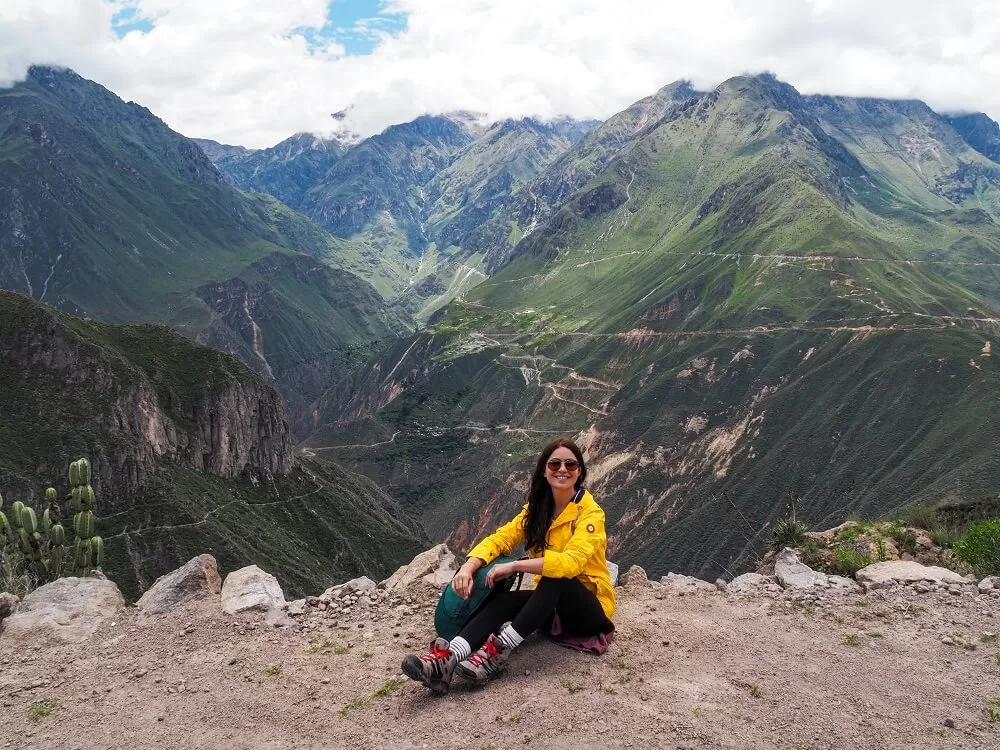
How to Prepare for the Colca Canyon Trek
So, you’ve decided you want to trek in the canyon. To help you plan out your Colca Canyon trek, you can find detailed answers below to the most common questions we had beforehand. Hopefully by the end, you’ll have a better idea of when to hike, what to do with your extra luggage, what to pack, where to sleep and how much the whole Colca Canyon trek will cost you.
Best Time to Hike in the Colca Canyon
If you’re currently planning your Peruvian adventures, then you’re most likely checking when the best time to visit certain places is. Since Peru is a huge and very diverse country this can take a bit of planning.
The good news is that you can basically hike the Colca Canyon all year round. Now of course there are better and worse times to hike. The wet season is normally between November and April. Whilst visiting during this time frame doesn’t necessarily mean that you’ll be hiking in the pouring rain, the chances are much higher. You really want to enjoy the jaw dropping scenery and not be wishing the trek was over because you’re soaking wet and feel miserable.
If you come just before the dry season around April, then you might have a pleasant and rain free hike. It’s also less busy with tourists, so a good time to come to avoid the crowds.
The dry season is from about May to October. This time frame definitely gives you a high chance of a sunny and enjoyable trek. However, it’s also the most popular tourist time too, so be prepared for a lot more people to be on the trail with you. It can also get a bit too hot, so make sure you’re prepared for that to avoid heat stroke.
For reference, we completed the trek in March and since the rainy season was just about to end, the canyon was still a lush green color instead of a dry yellow like we saw on many people’s photos. Another bonus to coming around March / April.
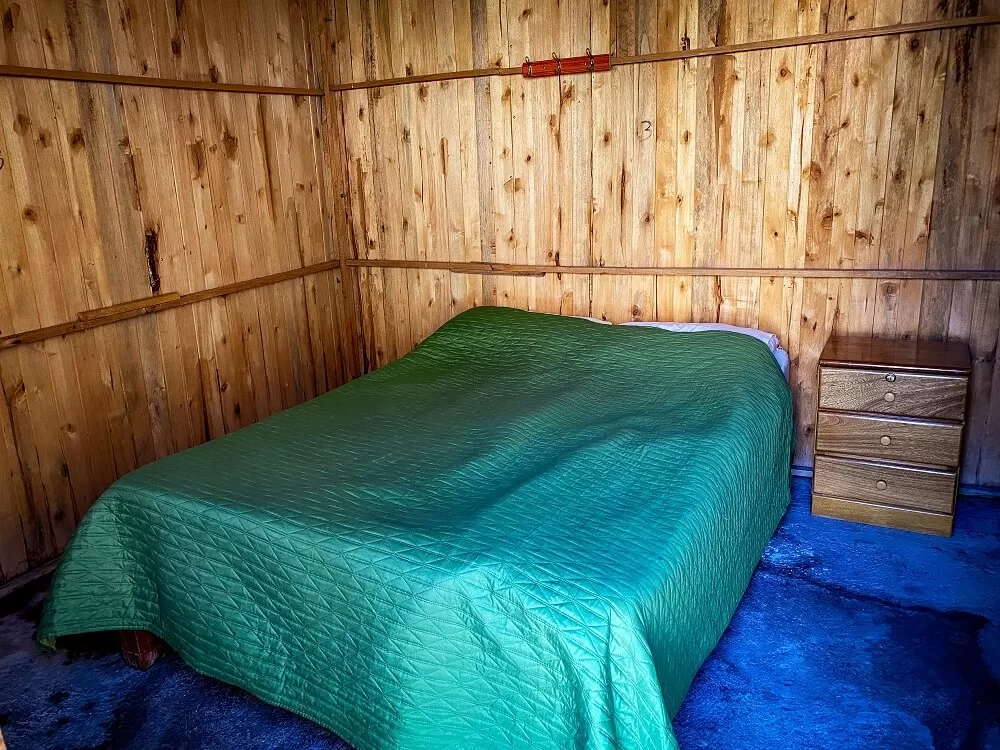

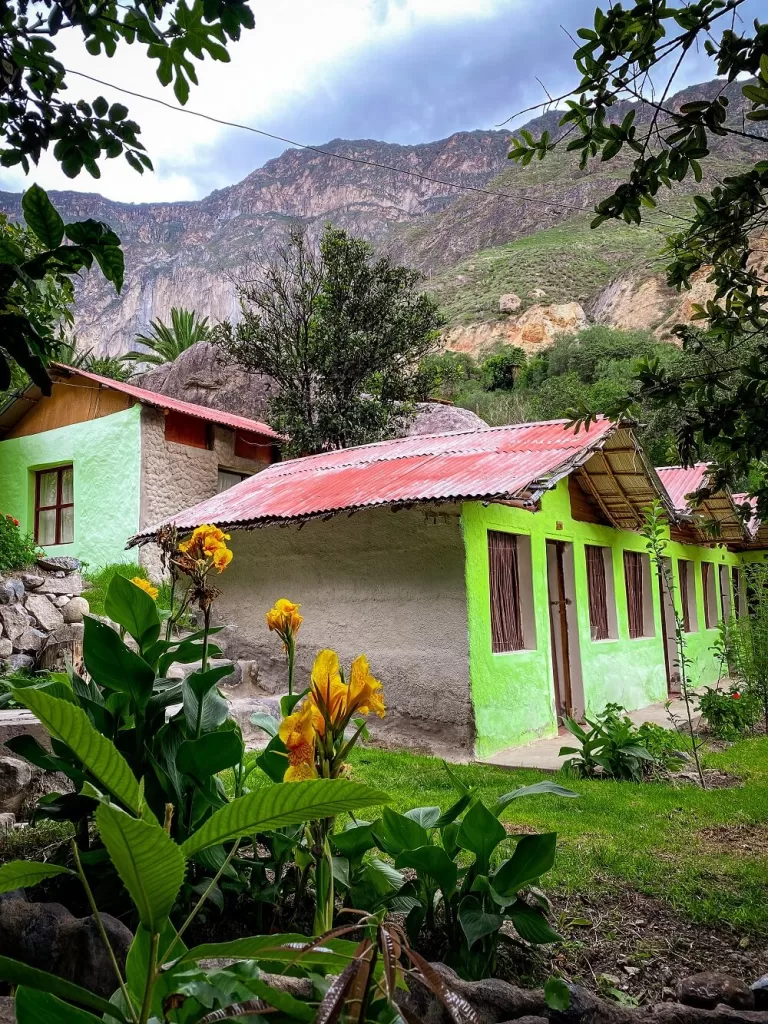
Where to Stay on the Colca Canyon Trek
If you’re joining an organised trek, then you don’t need to worry about your accommodation. However, if you’re doing the hike independently, then you should book it before your hike.
If you’re doing a 2-day trek you’ll normally stay in Sangalle, the deepest part of this section of canyon, located about 2,100 m (6889 ft) above sea level. Sangalle is a lush green oasis with a tropical microclimate. It has some simple accommodation you can book such as Paraiso Las Palmeras Lodge, Oasis Paraiso Ecolodge and Eden Lodge.
If you’re completing a 3-day trek, then, depending on your route, you can stay in San Juan de Chuccho or at Llahuar Lodge on your first night. If you’re booking a guided tour, the most popular route they will take you on is via San Juan de Chuccho. Only a few tours will take you via Llahuar Logde, so make sure to check the exact route before booking. Of course, you can always arrange the trek independently and plan the route you want to complete.
It’s worth noting that these accommodations will be very basic. You’ll normally have a bed and maybe a side-table in your room and that’s it. But, honestly, you won’t need more luxury than that anyway. They normally have communal areas where you can hang out and make friends with fellow hikers and eat your meals. Most of them will have shared bathroom and shower facilities. They also have swimming pools or hot springs.


Where to Eat on the Colca Canyon Trek
If you’re visiting or trekking in the Colca Canyon with a tour, most of your meals will be included in the price. Normally a 2-day trek will include 2 breakfasts, 1 lunch and 1 dinner and the 3-day trek will include 3 breakfasts, 2 lunches and 2 dinners. It’s worth noting that water, soft drinks or alcoholic drinks aren’t included in your tour. However, you can buy them at your accommodations, so you’ll need to have enough money to purchase them.
Although you’ll have your main meals included, we recommend packing enough snacks to keep you going on the hike.
If you’re doing the trek independently, you can book the accommodations with breakfast included and pay extra for lunch and dinner there. The food is normally very nice and filling and you’ll need the energy to complete the hike. They also offer vegetarian and even vegan options upon request.
You can also buy additional water at your accommodation or in Cabanaconde before you start your trek. We recommend having a filtered water-bottle, so you can fill it up in the streams along the way.

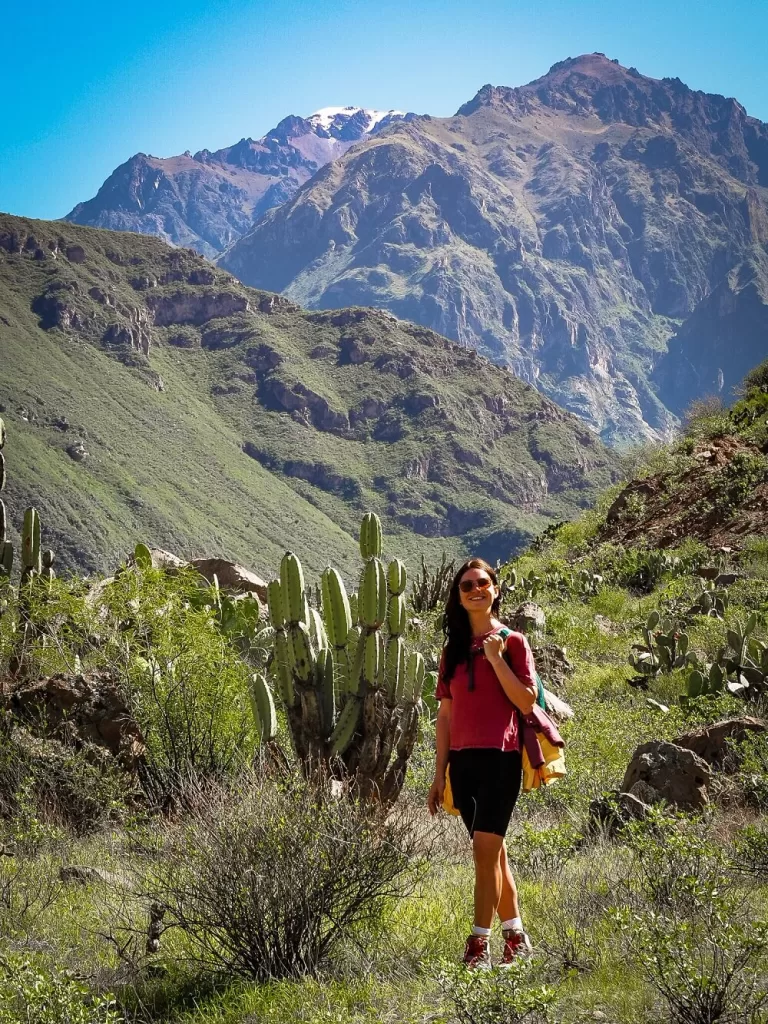
What to Wear and What to Pack for the Hike?
Clothing Items
Let’s talk about what to pack for the Colca Canyon trek. Ideally, you’ll want to carry a daypack that fits everything you’ll need for one or two nights.
In terms of a hiking outfit, we recommend packing both long trousers and shorts. The temperatures will change a lot depending on the time of day and what altitude you are at. Dress in layers and pack waterproofs like a rain jacket too.
In terms of footwear, it’s important to wear hiking boots or shoes that have good grip and support. We suggest packing some flip-flops or slides that you can change into after your hike when relaxing around your accommodation and swimming areas.
Obviously, make sure to pack everything you need for a few nights such as pyjamas, toiletries and so on. The accommodations will have pools, so pack some swimwear and quick dry towels too.
Electronics
In terms of electronics, don’t forget to pack your phone and camera gear. Although you might be able to charge your phone at your accommodation’s communal area, we recommend taking a portable charger just in case.
Bring a torch or headlamp! They will be essential when moving around the accommodation after dark and on your hike back up the canyon when you’ll start the hike in the dark.
For entertainment, we also packed our Kindles and some playing cards.
Accessories and Other Items
In terms of accessories for the hike, we recommend taking a reusable water bottle, sun-cream, a hat or cap and sunglasses for protection. Lastly, but most importantly, have enough cash on you to pay for anything extra.
We suggest having a basic first-aid kit with you with some painkillers, altitude tablets, band-aids and any prescribed medications.
Make sure to have your ID card or passport with you in a waterproof case.
All in all, try to pack as lightly as you can because, unlike the Inca Trail or Salkantay Trek, there aren’t any porters carrying your belongings. So, you’ll have to carry everything on your own even if you’re going with a guide.

What to Do with Your Extra Backpacks and Luggage?
If you’re travelling around Peru, chances are you’ll have a bigger luggage or backpack with you. We were on a one-year long sabbatical leave, backpacking through Mexico and South America before heading to Montenegro, Albania and then Turkey. So, it’s safe to say that we had everything but the kitchen sink with us.
Luckily, you don’t need to carry your big backpack or roll your wheelie suitcase up and down the second deepest canyon in the world. That would be a sight though!
The best option is to leave any extra bags at the hotel or hostel you stayed at in Arequipa. Depending on your itinerary you might spend an extra night in that accommodation after your trek anyway. Most places are happy to store your luggage for a night or two. Depending on your accommodation, you may or may not have to pay a small fee per night for this. If you’re taking a tour, the company might have space in their office to store your bags too, so it’s also worth asking. This is especially important if you’re travelling with a lot of valuable items such as laptops.
If you’re a slow traveller and are planning on spending an extended period of time in Arequipa, then you can book a longer Airbnb stay – which normally gives you a discount – and then leave your bags there. You’ll be paying double accommodation this way, so try to calculate which option will be more cost effective and secure before your visit.
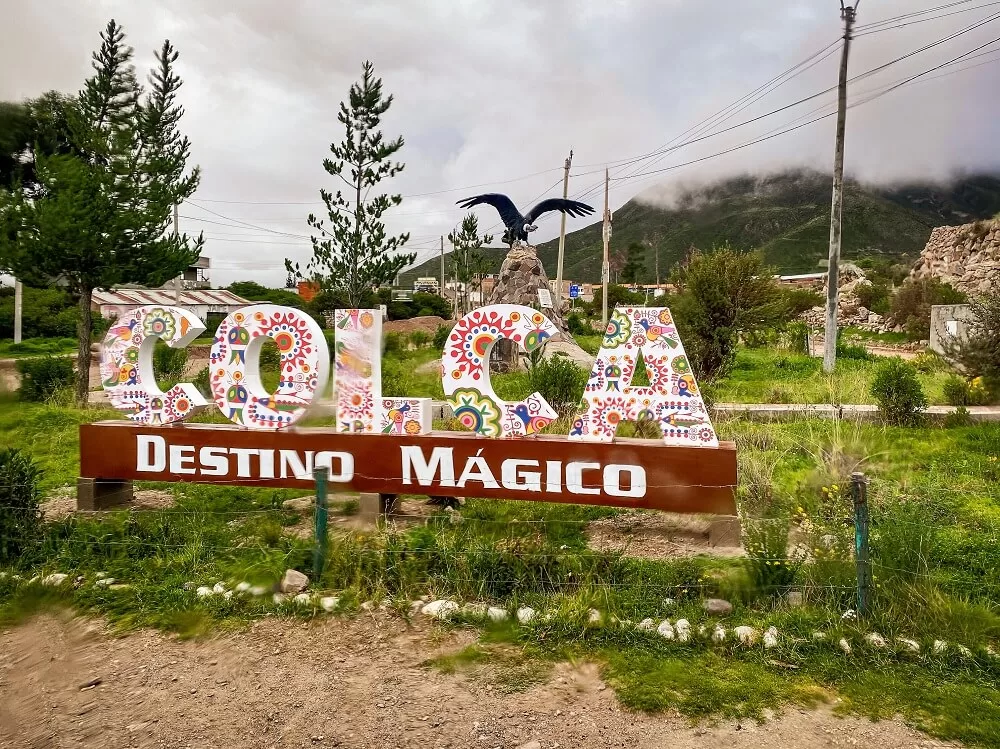
Transportation to and from the Trailhead
The Colca Canyon trek starts from Cabanaconde, a small village located about 200km to the north-west of Arequipa and about an hour’s drive west of Chivay.
If you’ve joined a guided trek then you don’t need to worry too much about getting to the trailhead. You’ll just need to get up on time and either get picked up from your accommodation or from the Plaza de Armas in Arequipa. Pretty much all tours will normally start around 3 AM. Yes, it’s an early start, but it takes a good 3 to 4 hours to reach the canyon. Plus you can just catch up on some sleep in the bus. Trust us, you’ll become an early bird during your time in Peru because many tours and treks, like the Inca Trail or the Salkantay trek, start early.
If you’re trekking without a guide, then you’ll need to catch a bus to either Chivay or Cabanaconde. There are a few direct buses to Cabanaconde from Arequipa but based on our research they are slower.
Many suggest that taking a colectivo from Arequipa to Chivay, then from Chivay to Cabanaconde will be the fastest way to get to the trailhead.
If you’re taking the bus, you have to get to Terminal Terrestre and if you’re taking a colectivo, you’ll have to go further down the main avenue to Transportes Centella. There are additional colectivo stations along the road, so it’s worth checking them out too. From Chivay, you’ll also have to get another colectivo to Cabanaconde.
We travelled with many colectivos across Peru. Things will likely be a bit confusing, but patience is always the key with transportation in this country. You’ll get to your destination eventually.
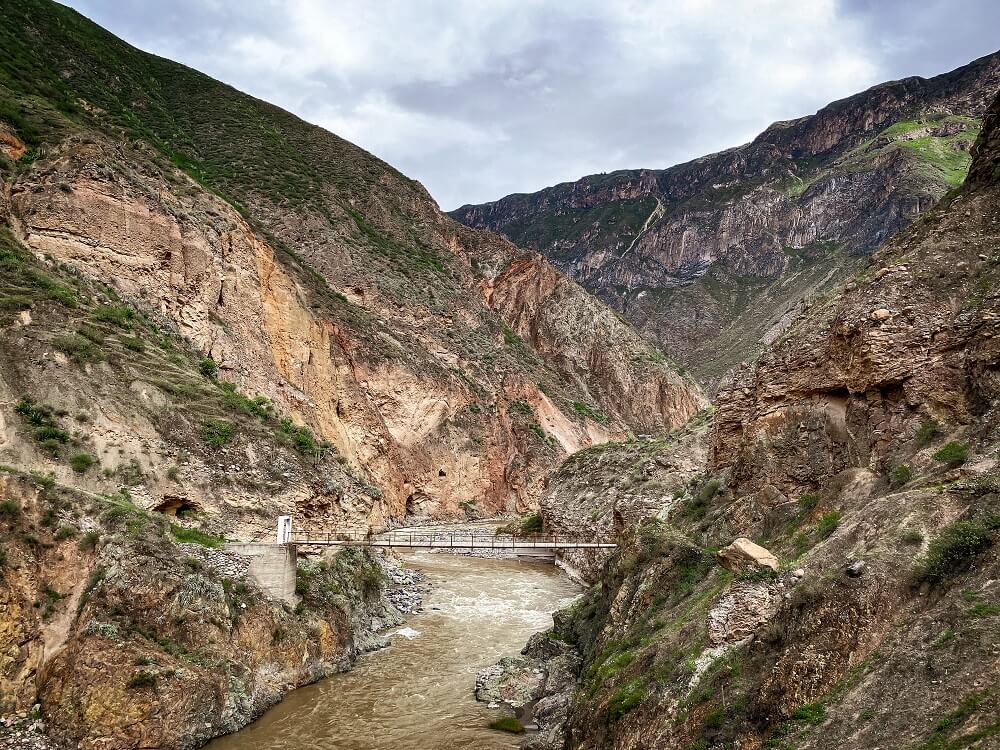
How Much Does the Colca Canyon Trek Cost
Alright, it’s time to add up how much you can roughly expect to pay for a visit to the Colca Canyon. It can differ greatly depending on how long you’re visiting for and what company you’re going with.
Colca Canyon Cost with a Guided Tour or Trek
- 1-day tour cost: around 30 – 60 USD per person.
- 2-day tour cost: around 40 – 80 USD per person.
- 2-day trek cost: 100 – 150 USD per person.
- 3-day trek cost: 160-250 USD per person.
- Colca Canyon entrance fee: 70 soles (19 USD) per person.
- Optional entry to Yanque hot springs: 15 soles (4 USD) per person.
- Additional food and drinks (water, sodas and alcoholic drinks) that aren’t included in your tour.
- Tips for your guide if you’re taking a guided trek or tour.
- Extra snacks you’ll buy for your hike.
- Potential extra fee for luggage storage.
Note. The cost of tours is a rough estimate. Prices can differ based on which company you go with, how long you’re going for and what’s included in your price. Many 3-day treks are also private, so they’ll cost a bit more. Make sure to look around online, have an idea of what you want to do and also check tour office prices once in Arequipa.
Colca Canyon Cost for an Independent Visit
- Transport to bus or Colectivo station: ~ 8-10 soles (2-3 USD) depending on where you’re staying (x2 for return trip).
- Bus to Cabanaconde: 20 soles (5.50 USD) per person. (x2 for return trip).
- Colectivo to Chivay: 20 soles (5.50 USD) per person. (x2 for return trip).
- Colcectivo to Cabanaconde: 10 soles (2.70 USD) per person. (x2 for return trip).
- Accommodation: 1 night is between 25 to 30 USD per room. It’s cheaper if you stay in a dorm room. (x2 if you’re hiking for 3 days).
- Colca Canyon entrance fee: 70 soles (19 USD) per person.
- Additional food and drinks (water, sodas and alcoholic drinks).
- Extra snacks you’ll buy for your hike.
- Potential extra fee for luggage storage.
Note. The above is per person, so you’ll have to double up most of it if you’re a couple. It’s going to be much cheaper than a tour. However, it’ll be more difficult to reach the additional destinations the tours normally stop at. We recommend having enough cash on you for any additional fees, as you’ll have to pay cash in most places.
Final Thoughts on the Colca Canyon Trek and Tour
The Colca Canyon was our first ever multi-day trekking experience and we loved it. We always knew that we wanted to trek in the canyon rather than just visiting it as part of a tour. Going with a guide was a great decision for us what with it being our first ever trek. This way we also had a chance to stop at the places that the day tours go to. Therefore, we didn’t miss out on anything like the Cruz del Cóndor and Patapampa viewpoints, the National Reserve of Salinas and Aguada Blanca and the hot springs at Yanque.
Have you ever visited the Colca Canyon before? If so, did you go on a trek or a tour? How was your experience? If not, would you add the Colca Canyon to your bucket list? Let us know in the comments below.
Now, let your adventure begin,

Our Top Travel Resources
Accommodation: For hotels we always use Booking.com and Hostelworld for hostels. We also book longer stays on Airbnb or Vrbo.
Flights: To find the best flight prices we always check Skyscanner, Google Flights or WayAway. Then we also check the airlines’ websites too for comparison.
Car Rentals: We use Discover Cars when we want to rent a car as it compares local, national and international companies.
Activities: If we book organised tours we always check either GetYourGuide or Viator.
Foreign Currency: Whenever we can we prefer to pay in local currency and for that we always use our Wise card. We can easily withdraw money from the ATM or pay by card at most shops and restaurants.
Travel Insurance: We never go anywhere without travel insurance. You never know what will happen on your trip, so good travel insurance like SafetyWing can protect you in case of injury, illness, theft and cancellations.
eSIM and VPN: To get data abroad we use Airalo which is an app that allows you to download a prepaid eSIM to your phone in over 190 countries. Make sure to have a VPN to avoid hackers accessing your personal data when using public WIFI. We use Surfshark which is the only VPN that offers one account on unlimited devices.
Remember…It all starts with a Pin…
